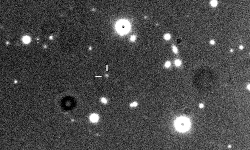Thyone
| Thyone | |
 Animation av Thyone från tre bilder tagna år 2001 av Canada–France–Hawaii Telescope | |
| Upptäckt | |
|---|---|
| Upptäckare | Scott S. Sheppard m.fl[1] |
| Upptäcktsdatum | 11 december 2001[1] |
| Beteckningar | |
| Alternativnamn | S/2001 J 2 |
| Uppkallad efter | Semele |
| Omloppsbana | |
| Halv storaxel | 21 406 000 |
| Excentricitet | 0.2526 |
| Siderisk omloppstid | 639.803 |
| Inklination | 147° |
| Måne till | Jupiter |
| Fysikaliska data | |
| Ekvatorradie | 2 |
| Massa | 9.0 × 1013 |
| Albedo | 0.04 |
Thyone (XXIX, S/2001 J2) är en av Jupiters månar. Den upptäcktes den 11 december 2001 av en grupp astronomer vid University of Hawaii ledd av Scott S. Sheppard.[1] Thyone är cirka 4 kilometer i diameter och roterar kring Jupiter på ett avstånd av cirka 21 406 000 kilometer.
Referenser
- ^ [a b c] ”Thyone” (på engelska). In depth; by the numbers. NASA Science. 5 december 2017. Arkiverad från originalet den 20 november 2021. https://web.archive.org/web/20211120182005/https://solarsystem.nasa.gov/moons/jupiter-moons/thyone/in-depth/. Läst 14 augusti 2019.
Externa länkar
| ||||||||||||||
Media som används på denna webbplats
This composite includes the four largest moons of Jupiter which are known as the Galilean satellites. The Galilean satellites were first seen by the Italian astronomer Galileo Galilei in 1610. Shown from left to right in order of increasing distance from Jupiter, Io is closest, followed by Europa, Ganymede, and Callisto.
The order of these satellites from the planet Jupiter helps to explain some of the visible differences among the moons. Io is subject to the strongest tidal stresses from the massive planet. These stresses generate internal heating which is released at the surface and makes Io the most volcanically active body in our solar system. Europa appears to be strongly differentiated with a rock/iron core, an ice layer at its surface, and the potential for local or global zones of water between these layers. Tectonic resurfacing brightens terrain on the less active and partially differentiated moon Ganymede. Callisto, furthest from Jupiter, appears heavily cratered at low resolutions and shows no evidence of internal activity.
North is to the top of this composite picture in which these satellites have all been scaled to a common factor of 10 kilometers (6 miles) per picture element.
The Solid State Imaging (CCD) system aboard NASA's Galileo spacecraft acquired the Io and Ganymede images in June 1996, the Europa images in September 1996, and the Callisto images in November 1997.
Launched in October 1989, the spacecraft's mission is to conduct detailed studies of the giant planet, its largest moons and the Jovian magnetic environment.Författare/Upphovsman: David Jewitt/Scott Sheppard/Canadian Astronomy Data Centre, Licens: CC BY-SA 4.0
Animation of three discovery images of Jupiter's irregular moon Thyone (S/2001 J 2), taken by David Jewitt and Scott Sheppard using the 3.6-meter Canada-France-Hawaii Telescope (CFHT) on 11 December 2001. Each image was taken approximately 40 minutes apart, showing the moon's motion relative to the background stars and galaxies. The dark round spots are image artifacts. The apparent magnitude of Thyone is 22.5. The raw image datasets used are 615432p, 615439p, and 615446p. For comparison, the star field in these images can be viewed at the CDS's Aladin star atlas.


